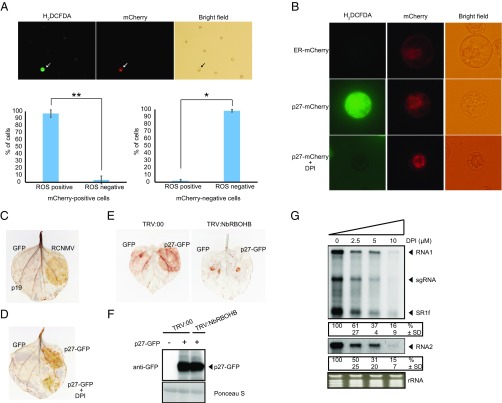Fig. 3.
RCNMV promotes ROS production in an infected cell via the p27 replication protein in an RBOH-dependent manner. (A) The H2DCFDA-stained tobacco BY-2 protoplasts inoculated with recombinant RCNMV that expresses mCherry. RCNMV-infected cells are marked by arrows. H2DCFDA-positive and H2DCFDA-negative cells were counted for mCherry-positive (about 40 cells per experiment) and mCherry-negative (about 300 cells per experiment) cells, respectively. Graphed data are means ± SD from three independent experiments; *P < 0.005, **P < 0.001, Student’s t test. (B) The H2DCFDA-stained tobacco BY-2 protoplasts inoculated with p27-mCherry-expressing plasmids. Protoplasts were treated with DMSO or 10 μM RBOH inhibitor DPI for 16 h postinoculation. A plasmid expressing mCherry containing ER-targeting signal (ER-mCherry) was used as a negative control. (C and D) DAB-stained N. benthamiana leaves transiently expressing RCNMV or p27-GFP by Agrobacterium-mediated infiltration. Leaves were treated with DPI (50 μM) at 1 d after infiltration and photographed at day 4. GFP or p19 was used as a negative control. (E) DAB-stained leaves of NbRBOHB-silenced and control N. benthamiana plants (TRV:00) expressing p27-GFP. (F) Accumulation of p27-GFP in N. benthamiana leaves silenced for NbRBOHB. Total protein was extracted and analyzed by immunoblot using an anti-GFP antibody. (G) Accumulation of RCNMV RNA in N. benthamiana protoplasts. The protoplasts were inoculated with in vitro synthesized RNA1 and RNA2 and incubated at 17 °C for 16 h in the presence of various concentrations of DPI. Ethidium bromide-stained rRNA is shown below the Northern blots, as loading controls. The numbers below the images represent the relative accumulation levels (means ± SD) of viral RNAs (RNA1 and RNA2, respectively) from three independent experiments.

